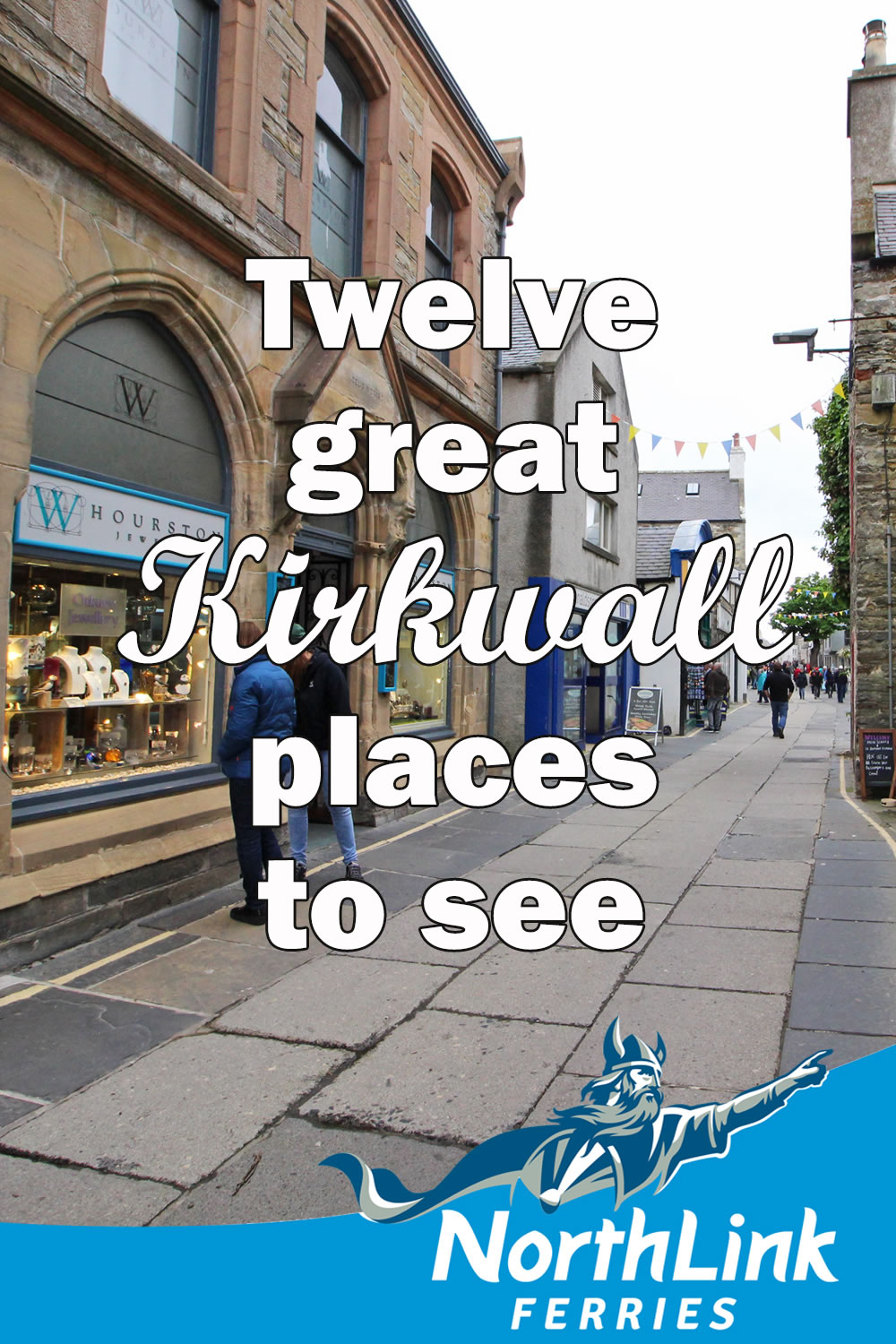Twelve great Kirkwall places to see
The historic town of Kirkwall is the capital of Orkney and home to some of the most magnificent buildings in the islands. It has around 9,000 residents and is the centre for local services.
At the time the Cathedral was built, the town was growing around the head of the bay. The main shopping street now roughly marks where the shoreline once was. A long shingle ayre reached out halfway across the bay and this created a sheltered entrance to Kirkwall’s old harbour. Modern visitors to Kirkwall would recognise the long shingle ayre as Ayre Road. Eventually the bay was sealed off, leaving a small loch now known as the Peedie Sea.
Orkney’s hospital (its shape inspired by Iron Age brochs) is here, as is the Orkney Islands Council, the Orkney Auction Mart, the Pickaquoy Leisure Centre, the Orkney College, and the Kirkwall Grammar School (and hostel for North Isles pupils). Kirkwall has the oldest library in Scotland, which was established in 1683 and, just outside the town, the islands’ main airport.
Inter-island ferries to Orkney’s north isles can be caught from harbour, and the NorthLink’s service to Aberdeen and Lerwick leaves from Hatston, on the outskirts of the town.
Kirkwall also has a superb range of hotels, restaurants, pubs, and shops. On a Saturday it can seem as though all the people of Orkney are visiting ‘the toon’.
We’ve compiled a list of 12 great places to see around Kirkwall, the busy heart of Orkney!
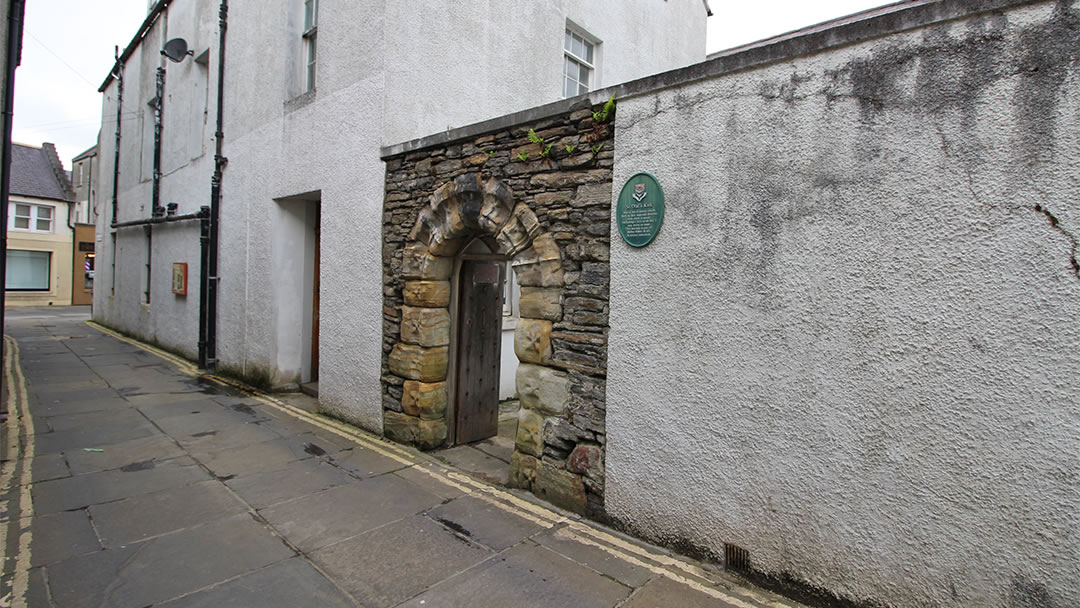
1. St Olaf’s Kirk
The name Kirkwall comes from the Old Norse, Kirkjuvagr, meaning ‘Church Bay’, and at first you might think the church is St Magnus Cathedral, which dominates the skyline. However, the name refers to the smaller and much older St Olaf’s Kirk. All that remains now of St Olaf’s Kirk is a lovely stone archway up a close from Bridge Street and a hog backed grave slab in the Orkney Museum.
The first historic reference to the town is within the pages of the Orkneyinga Saga, when Earl Rognvald Brusison built St Olaf’s Kirk in 1046. He was the first Earl to rule from Kirkwall.
At that time, Kirkwall was a growing village, a crossroads between the west and east mainland and the north and south isles, which sat on the edge of a bay where ships could shelter in all weathers. The oldest part of Kirkwall was built around and to the north of St Olaf’s Kirk.
No one knows how long the settlement was there, and it was probably in existence long before the church was built.
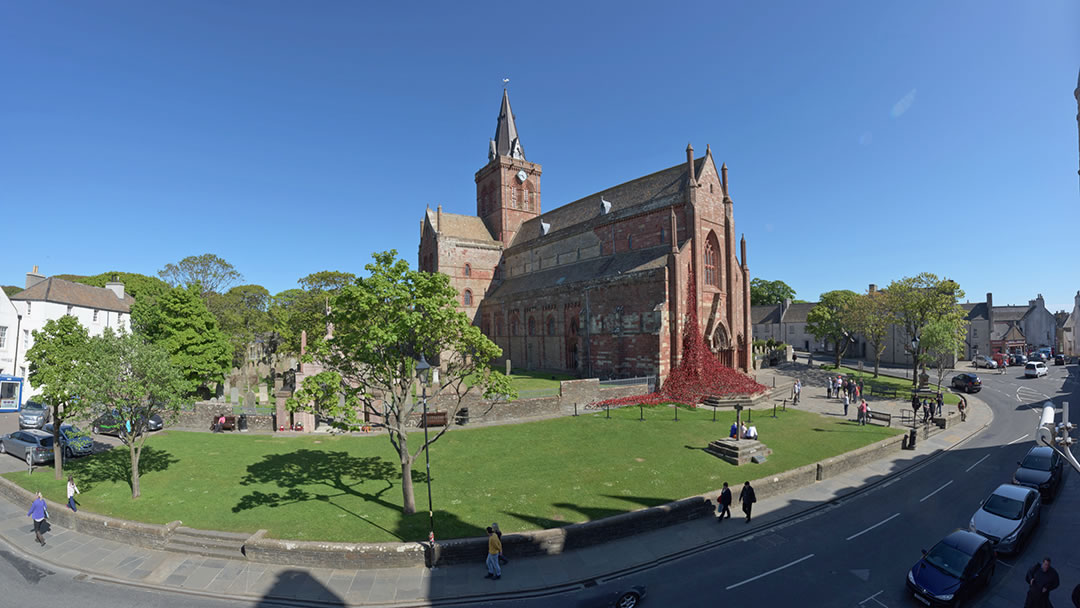
2. St Magnus Cathedral
A century later, another Earl Rognvald made an important vow. Earl Rognvald Kolson, nephew of Magnus, saint and martyr decided to build a cathedral in Kirkwall. It would be dedicated his uncle, and placed in the centre of Orkney, in a town where merchants, skippers and lairds went about their business.
The cathedral was to be for all the people of Orkney, but the build (which also established a new and powerful centre for the bishopric) was also a means to gain support from the church. Magnus’ body was moved from Birsay to St Olaf’s Kirk and work began on St Magnus Cathedral in 1137.
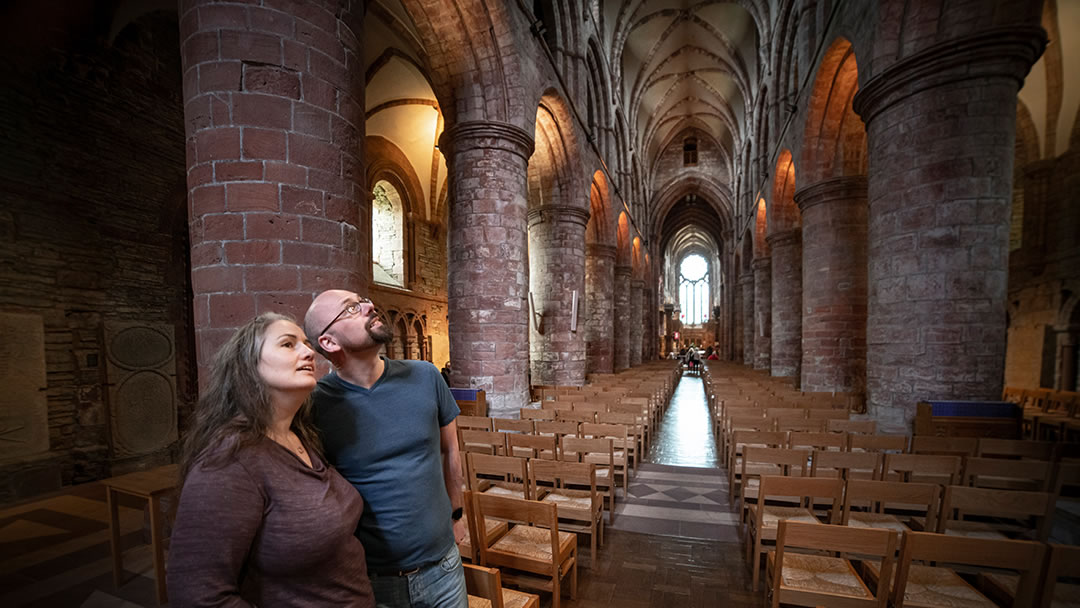
After 300 years a truly beautiful red sandstone cathedral was created. Magnus’ bones were placed within one of its pillars. St Magnus Cathedral is one of the oldest cathedrals in Scotland and still plays a central role in Orcadian life. It is a popular venue for church services, weddings, funerals, and the world-renowned St. Magnus Festival. Inside there is a lovely red gloom and colourful glimmers from the stained-glass windows. There are Romanesque rounded archways and Gothic pointed windows. A taller steeple was installed between 1913 and 1930.
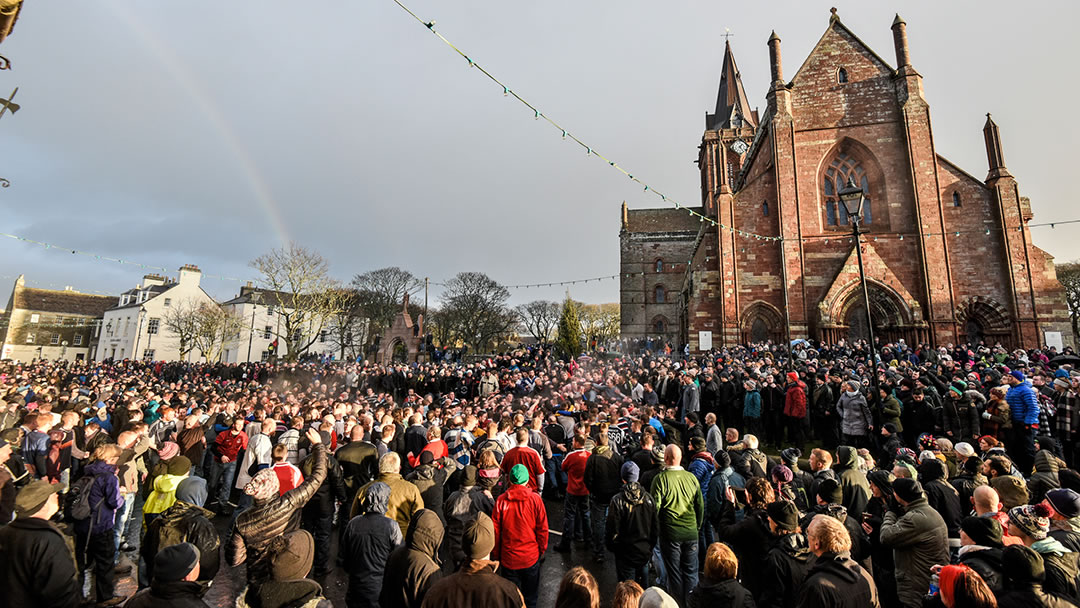
At the time the Cathedral was built, a second settlement formed around it called the Laverock. As years passed by, the Laverock and the older part of Kirkwall, called the Burgh, merged. Rivalry between the two settlements can still be felt today in the Ba’, a traditional game which pits one side of the town against the other.
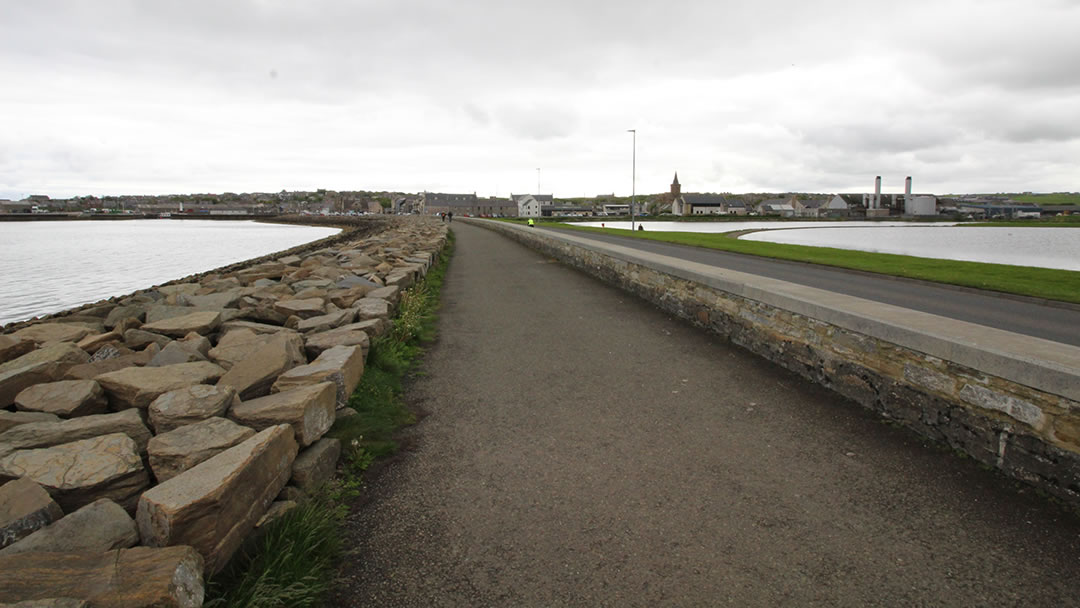
3. Ayre Road and the Peedie Sea
To think of Kirkwall in the past requires a bit of imagination, as much of the town as we know it today was reclaimed from the sea.
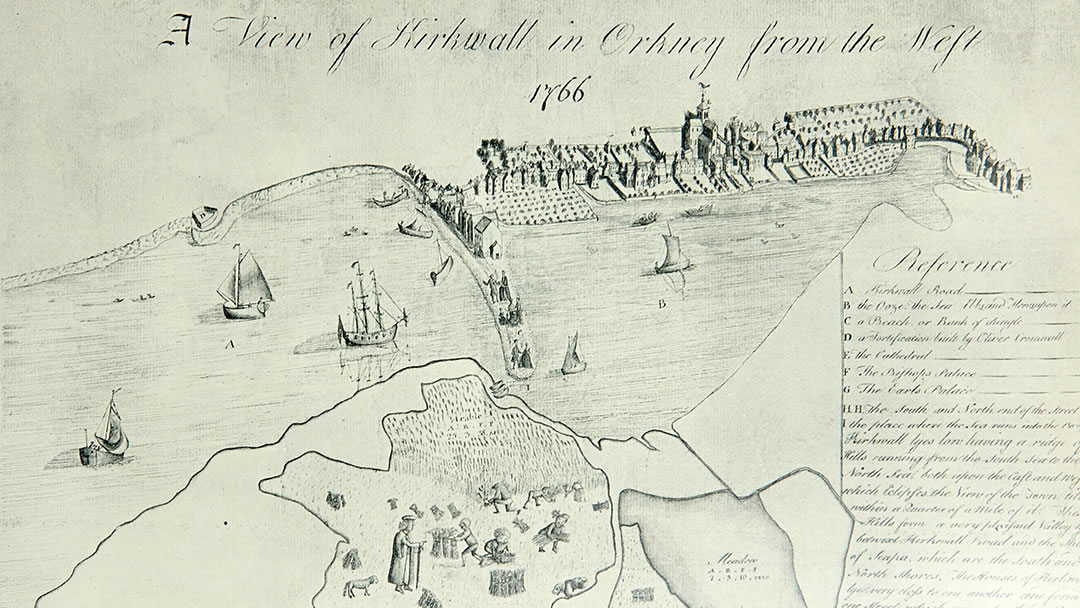
When the Cathedral was built, the town was growing around the head of the bay. The main shopping street now roughly marks where the shoreline once was. The sea was almost at the steps of St Magnus Cathedral. This made it easy to deliver the stone, quarried from near and far, that was required to build it.
A long shingle ayre reached out halfway across the bay, this created a sheltered entrance to Kirkwall’s old harbour. Modern visitors to Kirkwall would recognise the long shingle ayre as Ayre Road. Eventually the bay was sealed off, leaving a small loch now known as the Peedie Sea. Kirkwall’s main harbour now is along Harbour Street.
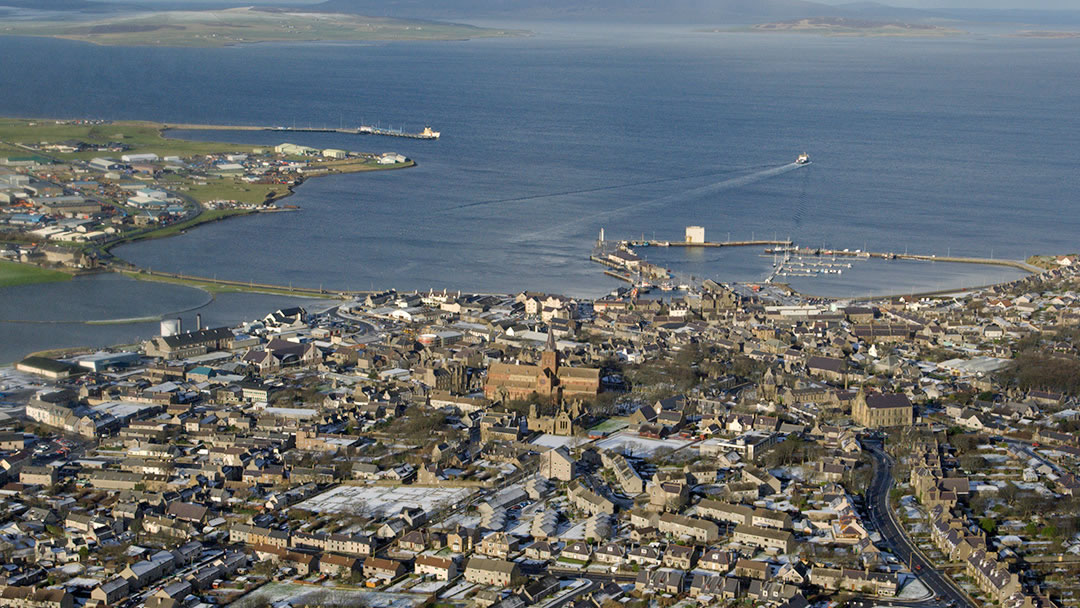
At the end of Ayre Road is Mills Filling Station, a reference to the watermill here which was powered by the ebb and flow of the tide.
Dumped earth and rubble gradually reduced the size of the Peedie Sea. Buildings and roads were built in front of what were once houses on the shore.
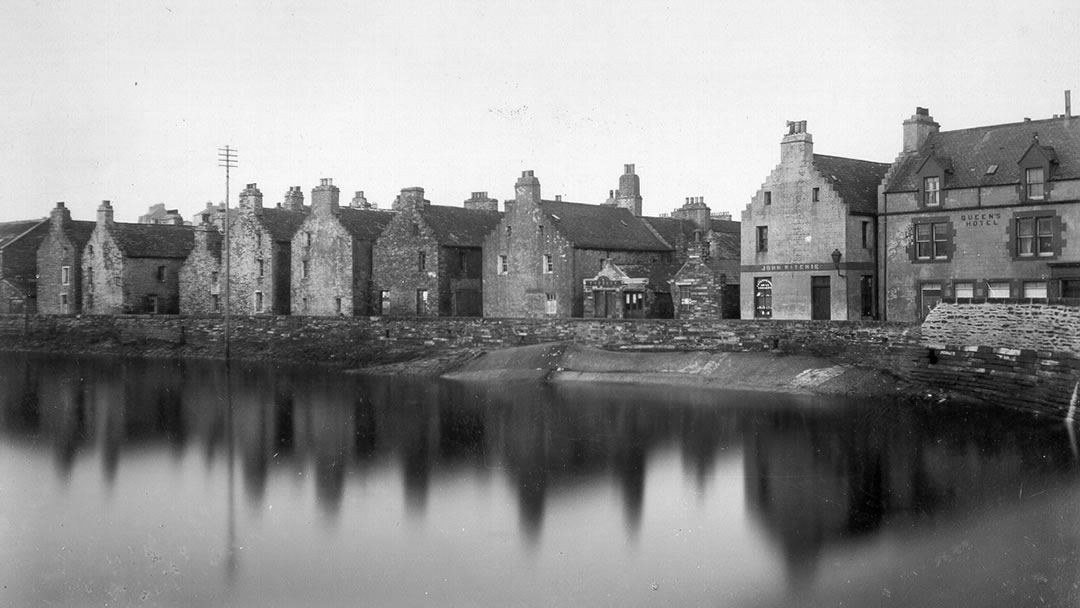
On Shore Street a line of houses faced their gable ends to the sea. This area, called the Ramparts, resembled Stromness and other waterfront towns in Orkney until the houses were demolished to make room for an oil depot.
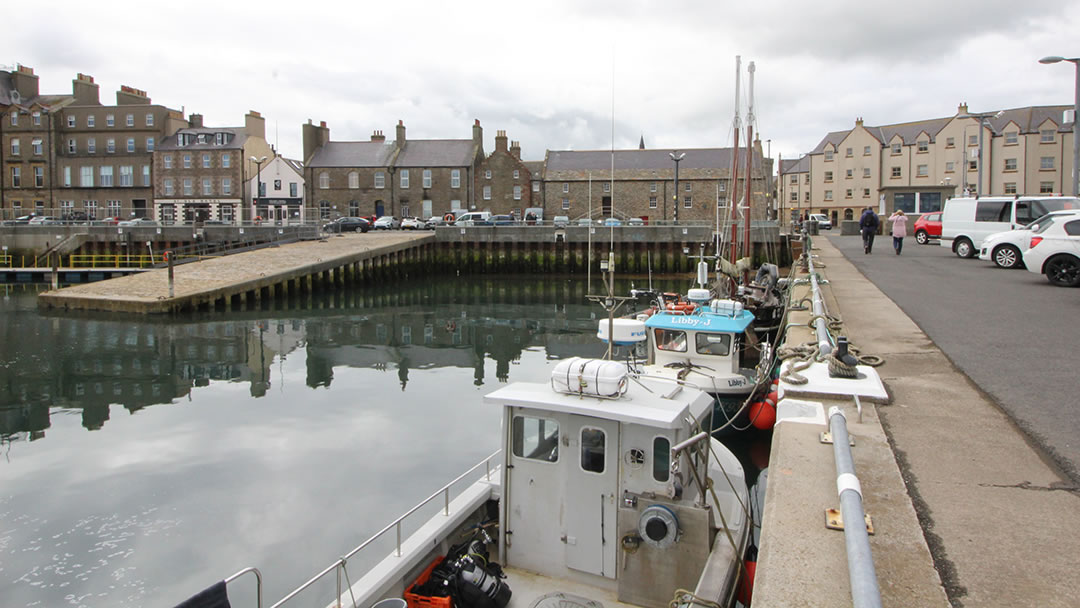
4. The Basin, the Cornslip, the Girnel and Kiln Corner
Harbour Street is a mixture of piers, jetties, and slipways opposite large Victorian hotels. The Basin is a deep-water area, formed by piers built on either side in the 19th Century and it is always busy with fishing vessels. Once it was where youngsters in Kirkwall learned how to swim. Kirkwall’s RNLI station is here and the present lifeboat, Margaret Foster. On newer piers, built further out, there are ferries to the North Isles and the Kirkwall marina.
The most prominent pier at the Basin is called the Cornslip. Throughout the years this jetty has been popular with youngsters fishing for sillocks. The name comes from a time when oats, bere, meal and malt was paid annually as rent by the tenants of the Earl. It was landed on the Cornslip and then stored in a warehouse across the road.
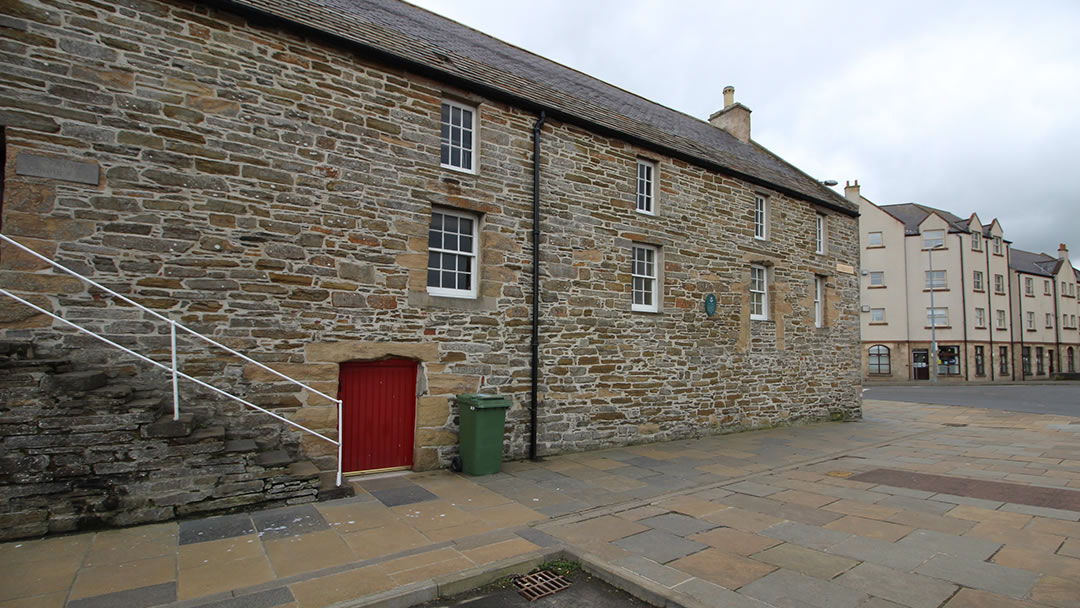
The warehouse, known as the Girnel (the name given to wooden chests used for storing things) was built in 1647 and is now the home of the Orkney Sailing Club.
Nearby there are modern buildings at Kiln Corner, and NorthLink Ferries have an office here. The name refers to the kiln built on the west end of the Girnel, which was used to dry grain before it was stored.
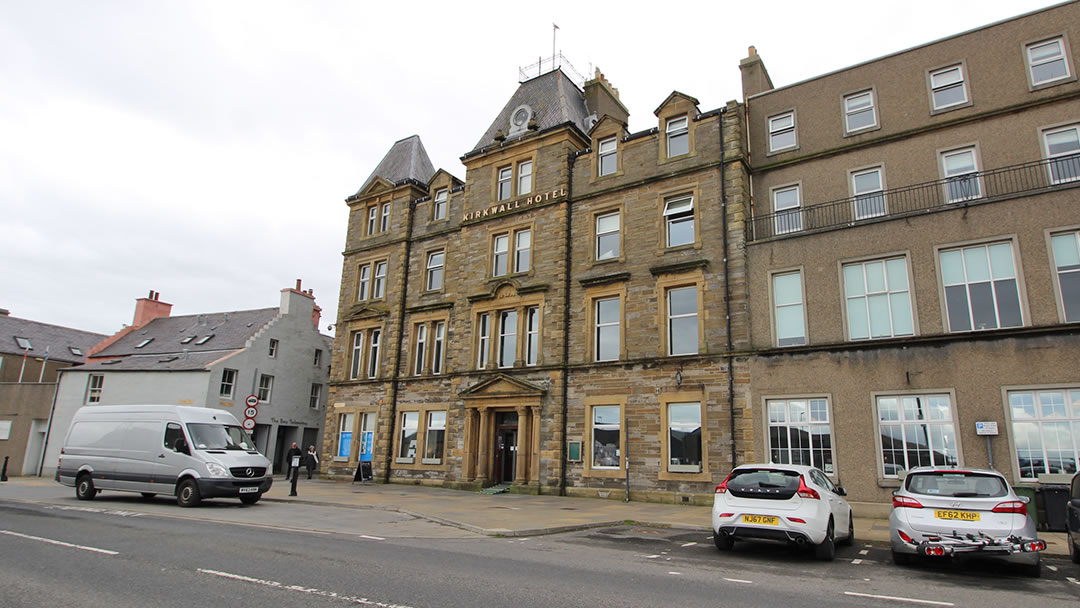
5. The Kirkwall Hotel
There are a range of fine buildings and businesses along Harbour Street. Amongst these is the Kirkwall Hotel, a grand Victorian building which overlooks the new pier. The Kirkwall Hotel was built in 1890 on the site of an older building and was designed by a local architect called T.S. Peace.
The impressive rooms inside are lit by sea glitter. Visitors might enjoy watching the daily comings and goings on the harbour. These piers have always brought business to the waterfront hotels; visitors from south and from the north isles, once using steam ships, and later, ferries and cruise ships.
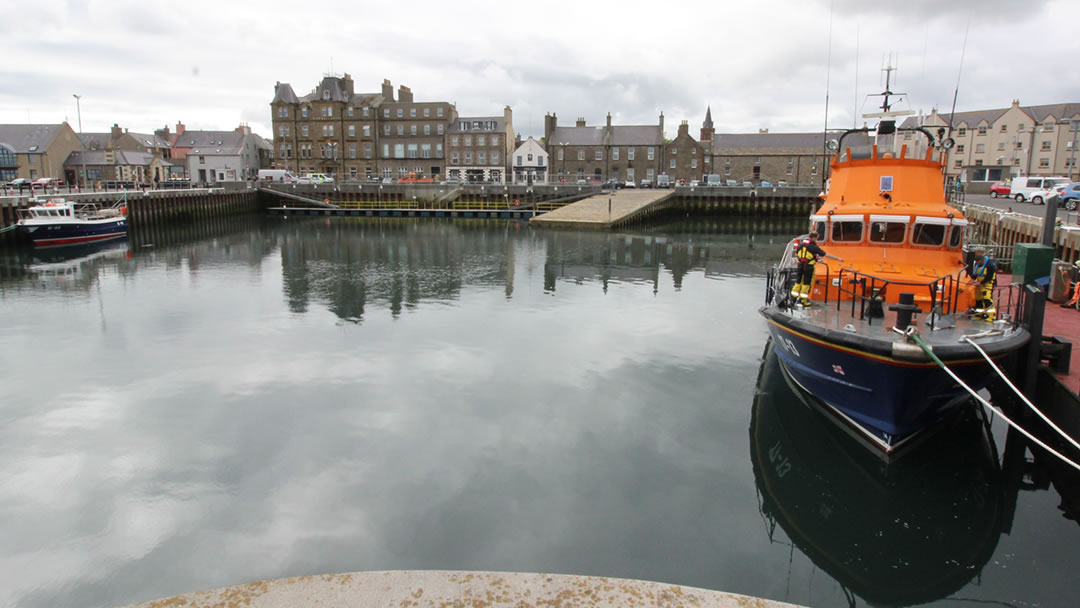
Between 1920 and 1947 Stromness was a dry town, and the Kirkwall Hotel was one of the few public bars on the Orkney Mainland where you could enjoy an alcoholic drink. Then, during World War II the hotel was used as the Royal Navy’s Command Centre, which meant that shipping in Orkney’s waters was controlled from here. It is hard to imagine the scene in 1939, when word was received that the battleship, HMS Royal Oak had been sunk nearby, with the loss of 835 lives.
Just around the corner from the Kirkwall Hotel is Bridge Street and the other shopping streets of Kirkwall.
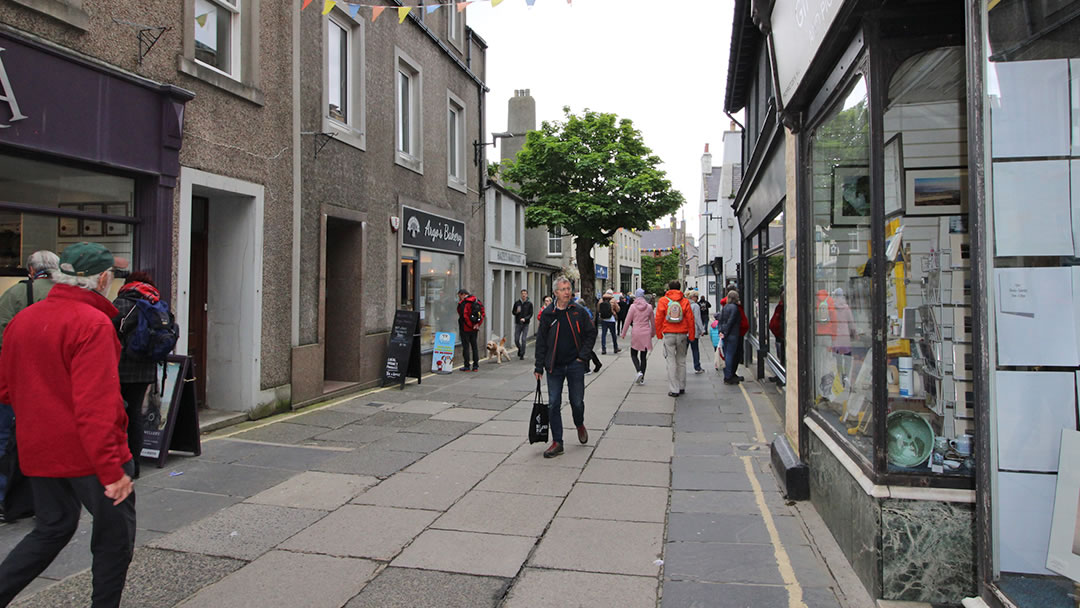
6. The main shopping streets
The main shopping street in Kirkwall starts at Bridge Street and continues into Albert Street, Broad Street and Victoria Street, following the old Kirkwall shore.
Along the street you’ll find lots of superb Orkney independent businesses including Sheila Fleet Jewellery, The Brig Larder, Ortak Jewellery, The Orcadian Bookshop, Donaldsons of Orkney, Grooves Record Shop, W Hourston Jeweller, Starlings, Aurora Jewellery, Highland Park, The Longship, Judith Glue, William Shearer, and a couple of chain-stores too.
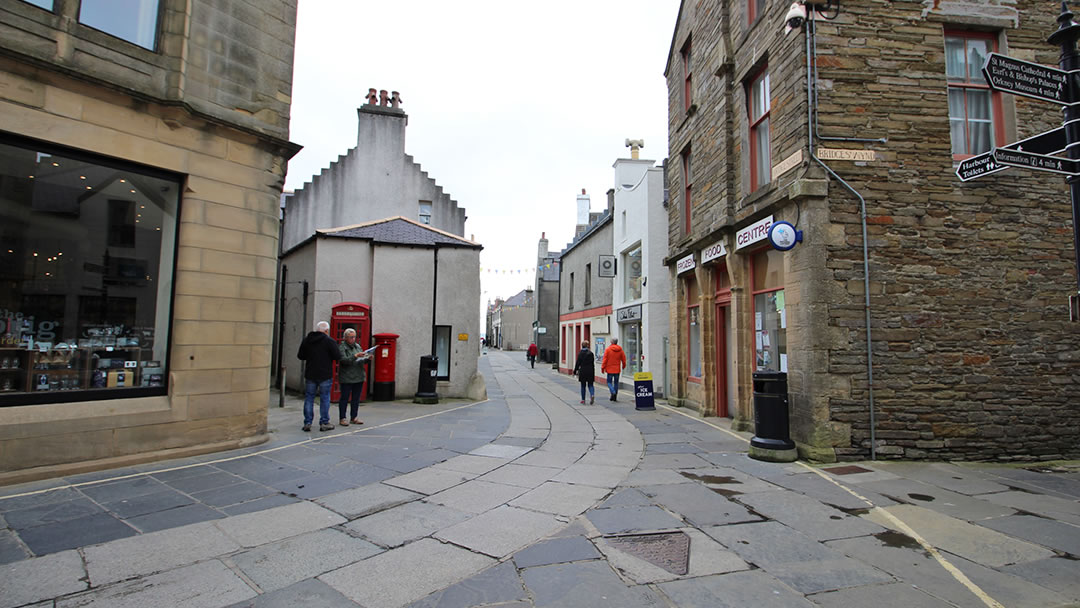
Bridge Street is named after a 17th Century bridge which crossed the Papdale Burn which flowed into the sea. These days you can still hear the burn water rushing below the manhole covers. Albert Street was named in 1841, the year after Queen Victoria married Prince Albert.
There’s a distinctive tree in the middle of Albert Street which is over 300 years old. The Big Tree was originally planted within a walled garden, but the garden was removed to make way for shop fronts and all the other trees were felled except for one.
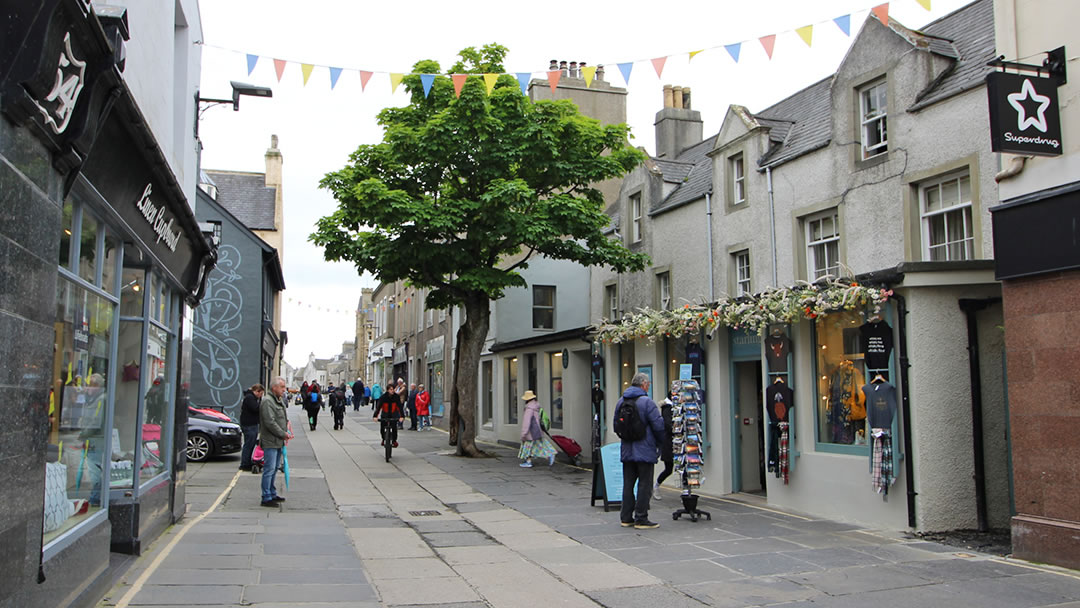
Throughout the streets of Kirkwall there are fine town houses which once belonged to lairds and their families. These were country people, made rich through the kelp trade (which provided potash and soda for the glass and soap industries) and shipping. In the winter, they would move to Kirkwall to enjoy a good social life. Their presence opened more shops in Kirkwall and made urban improvements happen quickly.
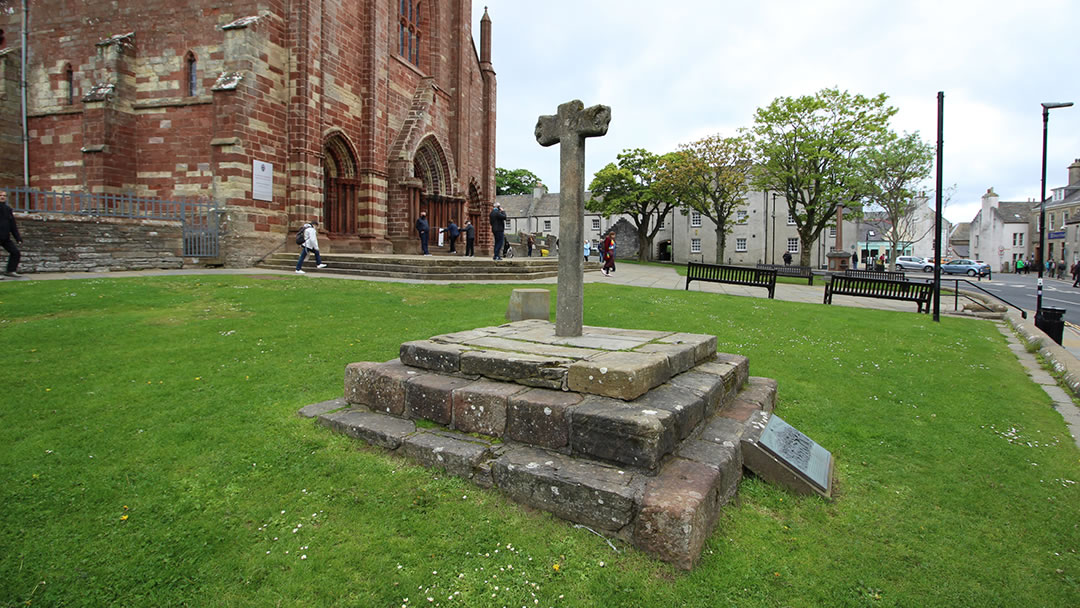
Broad Street is where St Magnus Cathedral is and the wide area in front is called the Kirk green. The Market Cross marks where deals were once made and where the Lammas Market was held, until WW2. Nowadays grooms or brides to be are often tied to it during ‘blackenings’ and at the start of the Ba’ game, the leather Ba is thrown from here.
Opposite the Cathedral, Kirkwall Town Hall is an impressive Baronial Style building built in 1884. It is used for meetings and functions and inside features a plaque listing previous Ba’ winners.
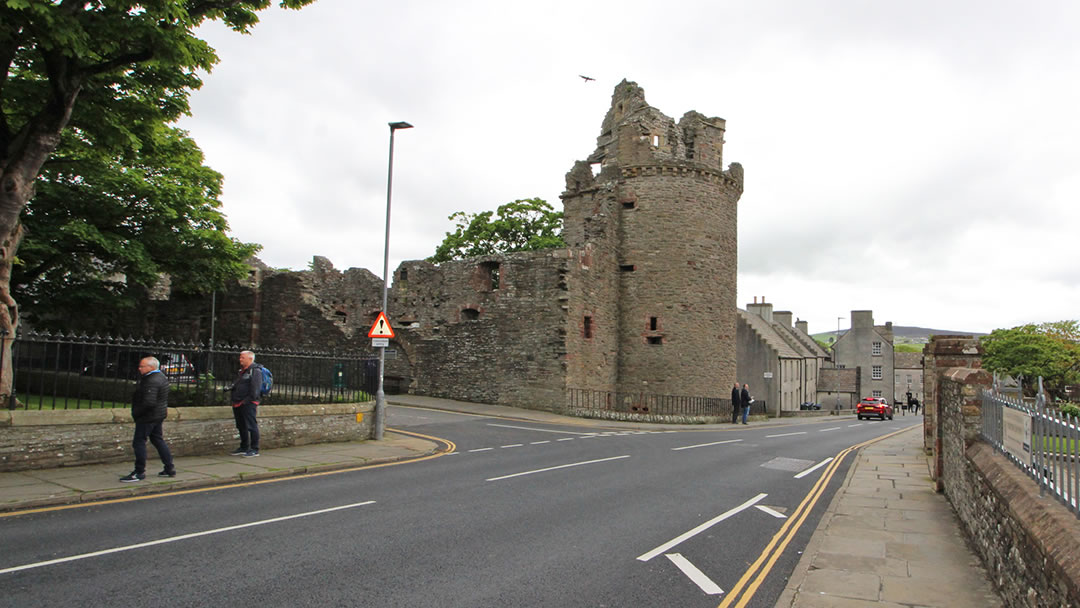
7. The Bishop’s and the Earl’s Palace
With the building of St Magnus Cathedral in 1137, the religious centre of Orkney moved from Birsay to Kirkwall. The Bishop’s Palace was built across the road from the Cathedral for Bishop William the Old in the 12th Century. This grand building was fit for royalty and later improvements included the splendid round ‘Moosie Tooer’. A fine view of Kirkwall can be had from the top!
The Earl’s Palace was built 400 years later to house the Earl, the ruler of Orkney. The Earl in question was an unpleasant one, Earl Patrick Stewart, but this splendid building was one of Scotland’s finest examples of Renaissance architecture. After Stewart’s execution it was passed from person to person, becoming uninhabitable just 100 years after being built.
The very grand buildings surrounding the Cathedral and the Bishops and Earls Palace housed the landed gentry and the clergy.
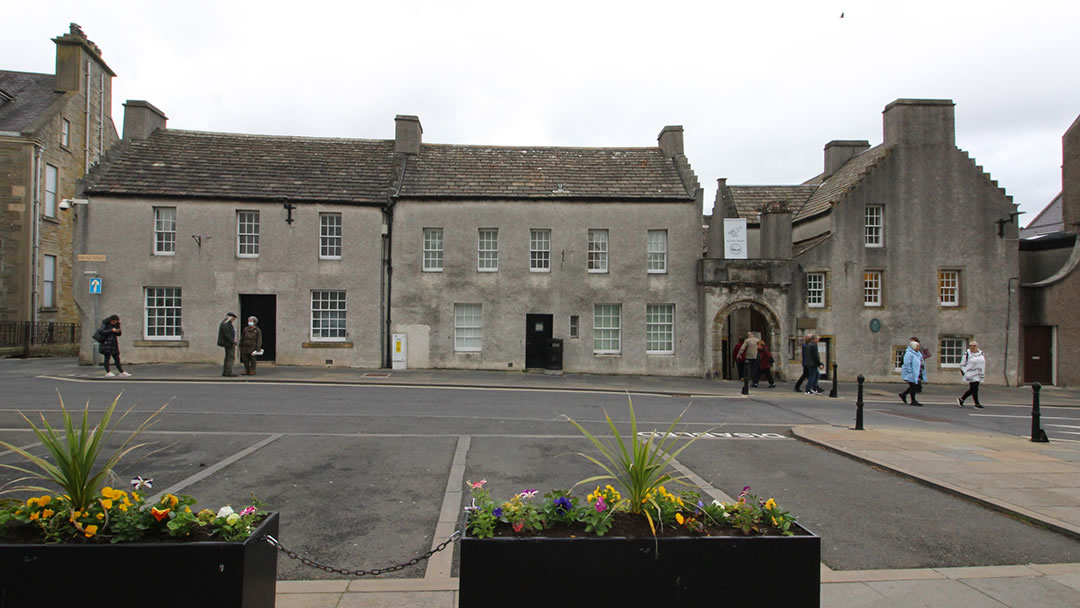
8. The Orkney Museum
The Orkney Museum is located in a grand building, which was not one house, but two large manses joined together in 1574 by Gilbert Foulzie, Kirkwall’s first Protestant Minister. From 1642 the house was owned by the Baikies of Tankerness, and it’s a labyrinthine building, easy to get lost in. But what a place to be disorientated! In every corner of the building there is a new treasure from 5000 years of Orcadian history.
Even for those familiar with Orkney, you’ll always discover a new fascinating fact during a trip to the Orkney Museum.
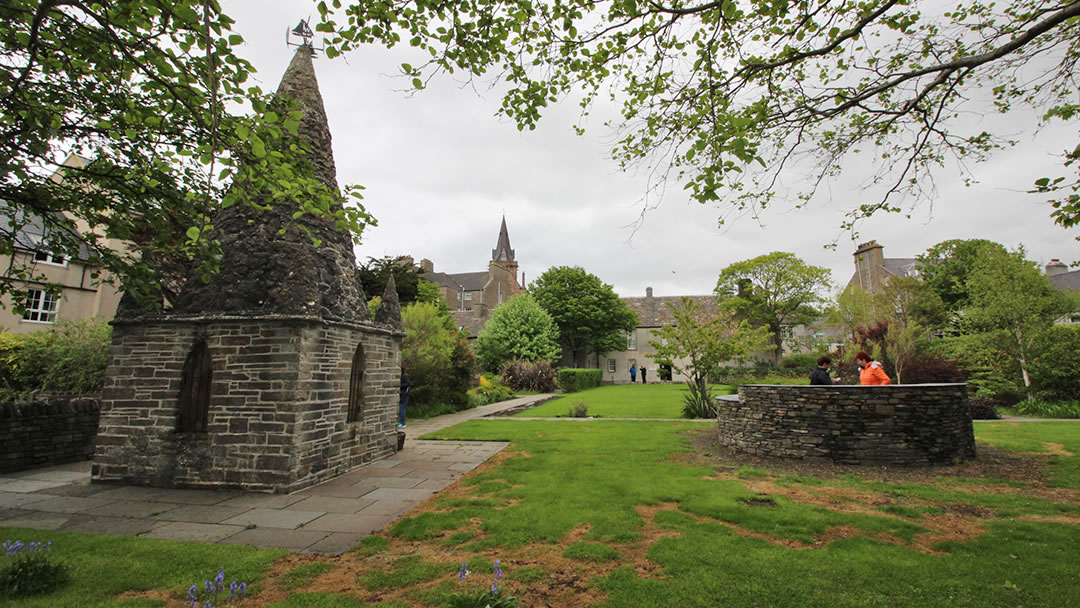
Outside the Orkney Museum is peaceful Tankerness House gardens, always rich in blossom. See if you can find there the Groatie House, a folly built (on Bridge Street but moved here later) using ballast from Pirate Gow’s ship.
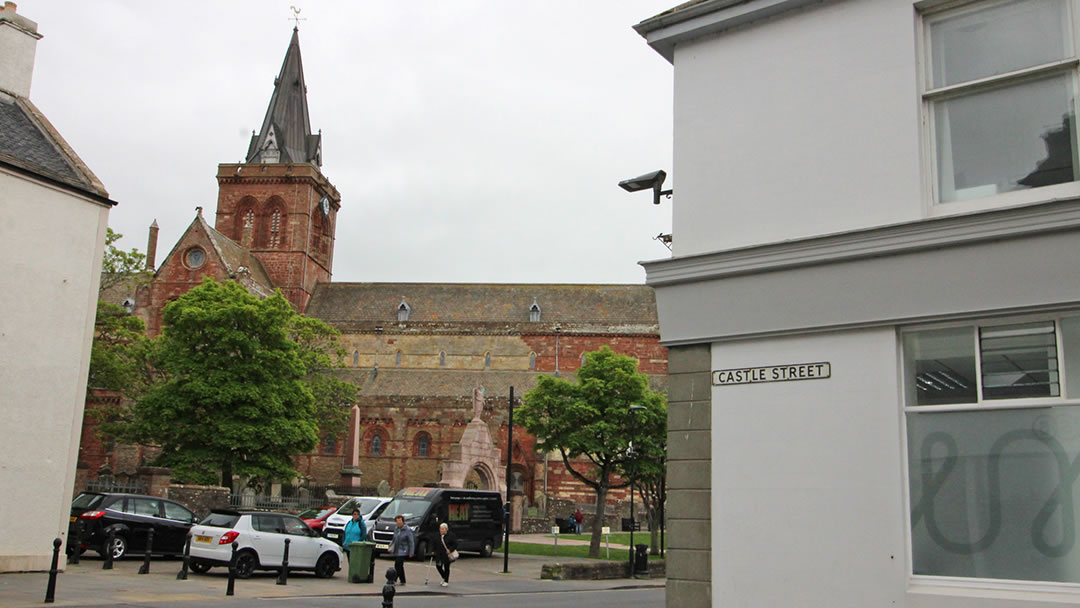
9. Kirkwall Castle
Kirkwall Castle was built in 1380 by Earl Henry St Clair and the history books state that it was an elegant castle which stood on the shore of the Peedie Sea, lapped by the water. Unfortunately, it does not exist now.
The demise of Kirkwall Castle began in 1614. After Earl Patrick Stewart was imprisoned, Robert Stewart raised a rebellion in support of his father, capturing St Magnus Cathedral, the Girnel, Earls Palace and Kirkwall Castle. The Earl of Caithness soon arrived and laid siege to Kirkwall Castle where Robert Stewart was hiding. Stewart’s men fired muskets from the Cathedral steeple whilst cannons were fired at the castle wall.
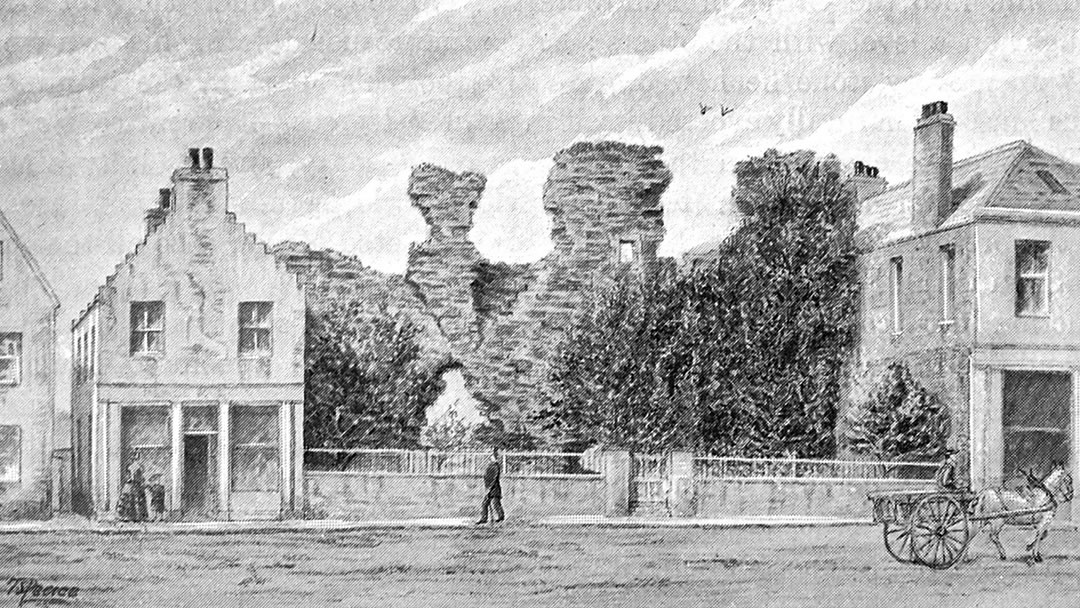
Remarkably Kirkwall Castle remained intact for a long time despite sustained cannon fire. Eventually, surrender was negotiated, and in 1615, Kirkwall Castle was destroyed. Its ruins were finally knocked down in 1865 in order to widen the roads for horses going to the pier.
All that remains now is the name ‘Castle Street’ where it once stood and some artefacts in the Orkney Museum. How grand it would be to have a castle to visit in Kirkwall now!
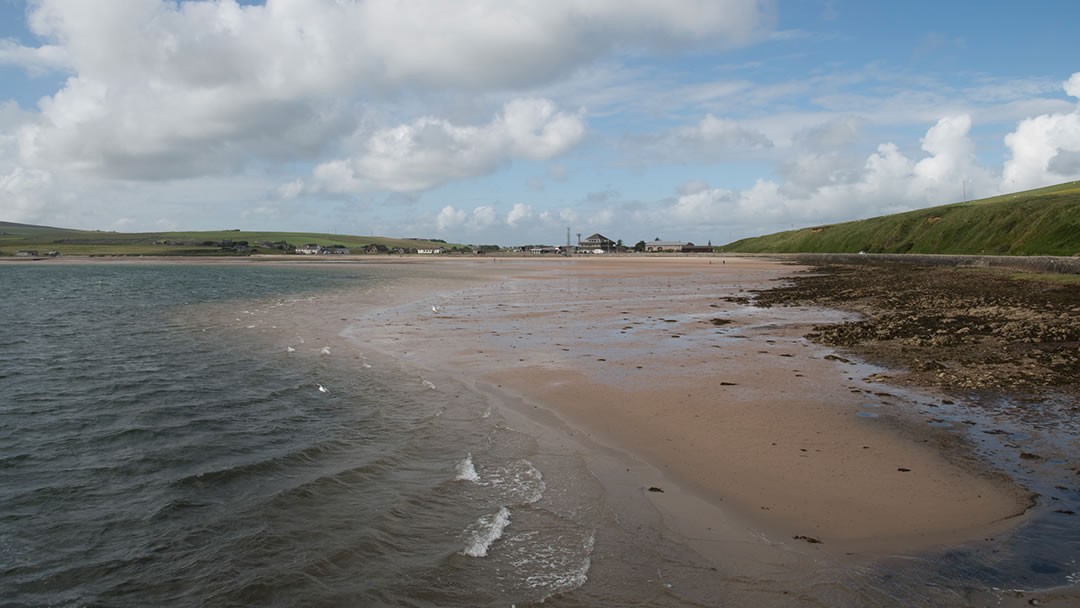
10. Scapa and The Royal Oak
Just outside of Kirkwall there are still areas of interest along the town’s edges. Just 1½ miles away, to the south is Scapa beach, and this is a popular spot for walkers. The beach looks out onto the tranquil waters of Scapa Flow.
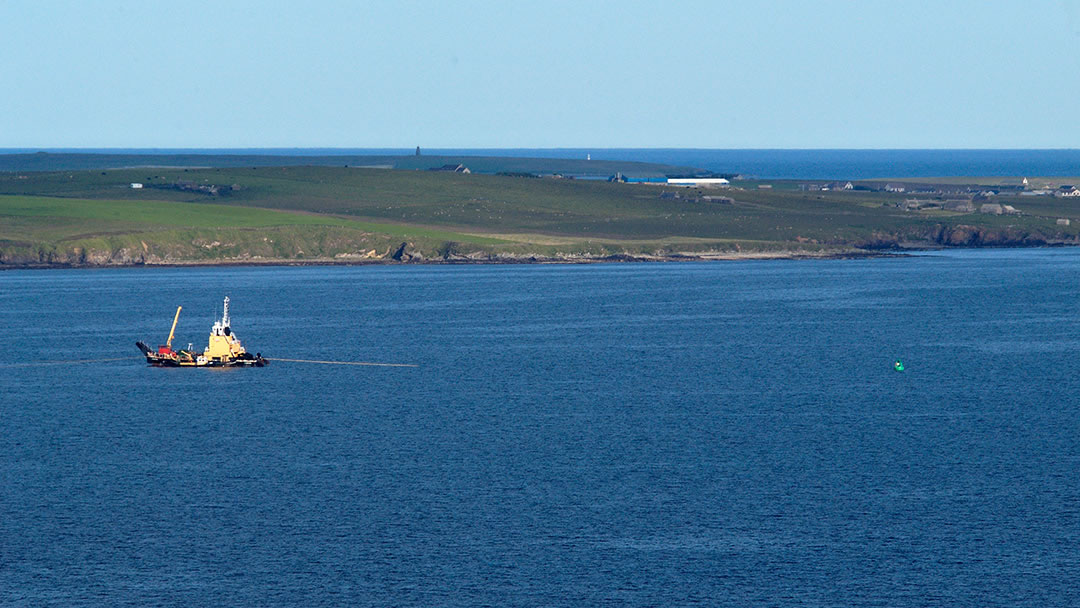
Further out there is the green HMS Royal Oak buoy and a small oil slick. This marks the place where the great battleship and her crew have their sea burial. She lies almost upside down, her hull is just 5m from the surface of the water.
In the past, Kirkwall folk were allowed to cut peat on the hillside above Scapa.
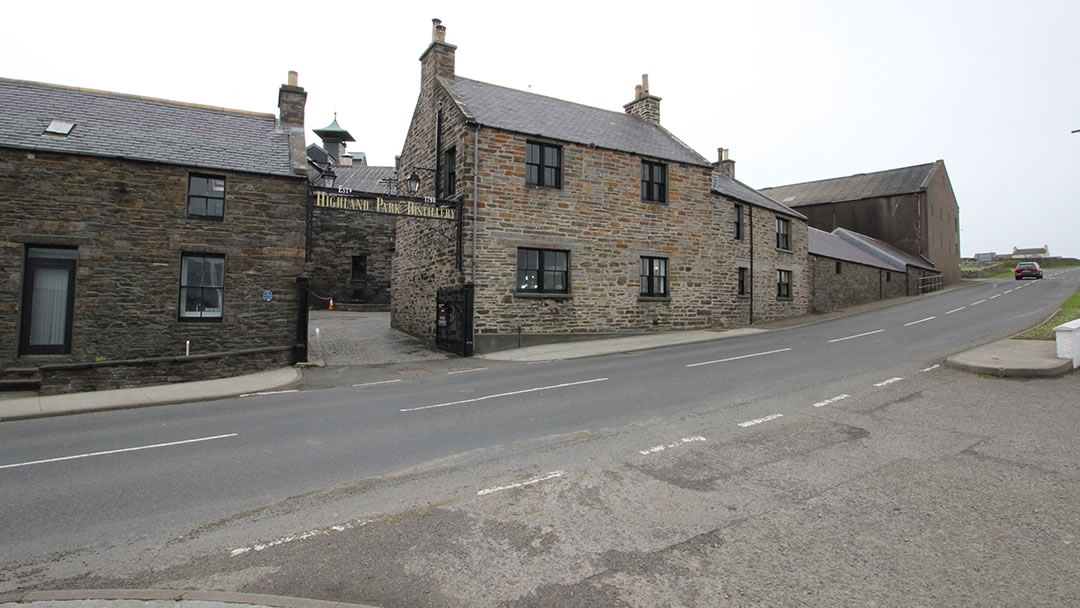
11. Highland Park Distillery and Scapa Distillery
Also on the edges of the town are Orkney’s two whisky distilleries and both produce a uniquely flavoured malt whisky.
Highland Park Distillery is a distinctive building on the A961 road, a steep hillside leading to Holm, Burray, and South Ronaldsay. It was founded by Magnus Eunson in 1798. He was a United Presbyterian Church Officer who distilled illicitly. Apparently, he kept whisky in his pulpit!
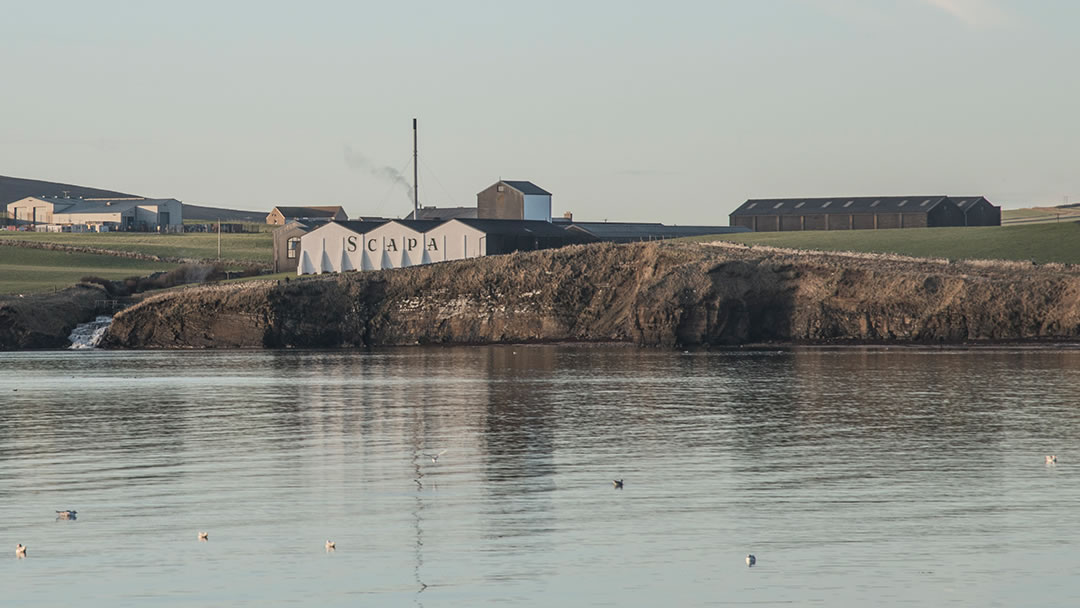
The bright white paintwork of Scapa Distillery, founded in 1885, stands out above Scapa Beach. This single malt distillery was almost destroyed by fire in 1919. Thankfully for whisky connoisseurs, Royal Navy sailors from Scapa Flow helped to save it.
These two distilleries are only half a mile apart from each other and are the two northernmost whisky distilleries in Scotland. Also, on the outskirts of Kirkwall, look for Orkney two Orkney Chair Makers, Scapa Crafts and Robert H. Towers.
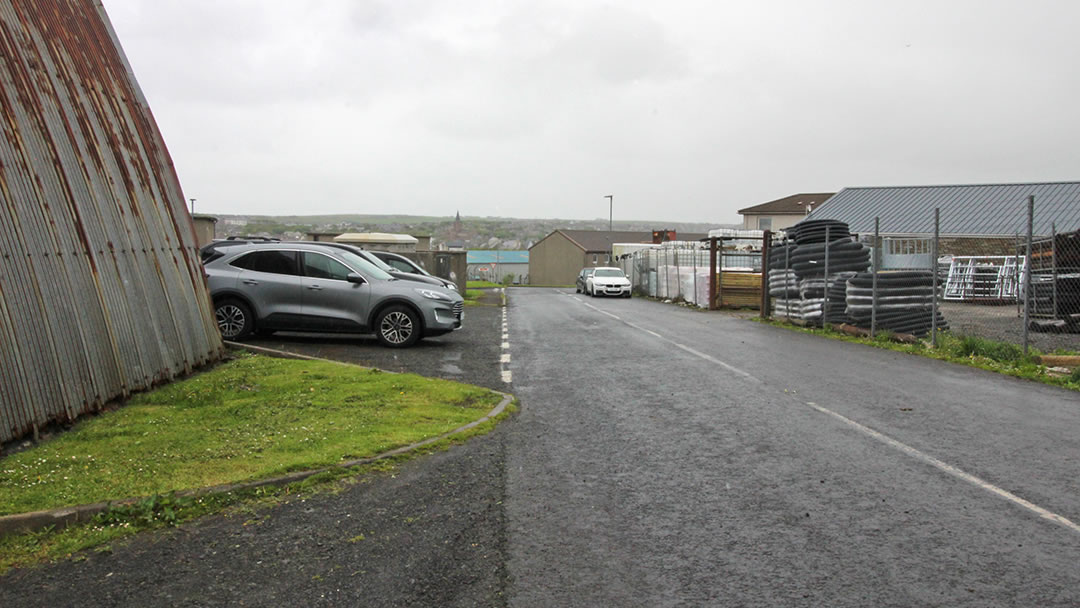
12. Hatston
On the western edge of Kirkwall there’s a sprawling industrial estate called Hatston. It began life as a grassy airfield in the 1930s, the early days of civil aviation. It became an important Royal Naval Air Station during World War 2 and was the first airfield in Britain with surfaced runways. Over 200 squadrons used the facility.
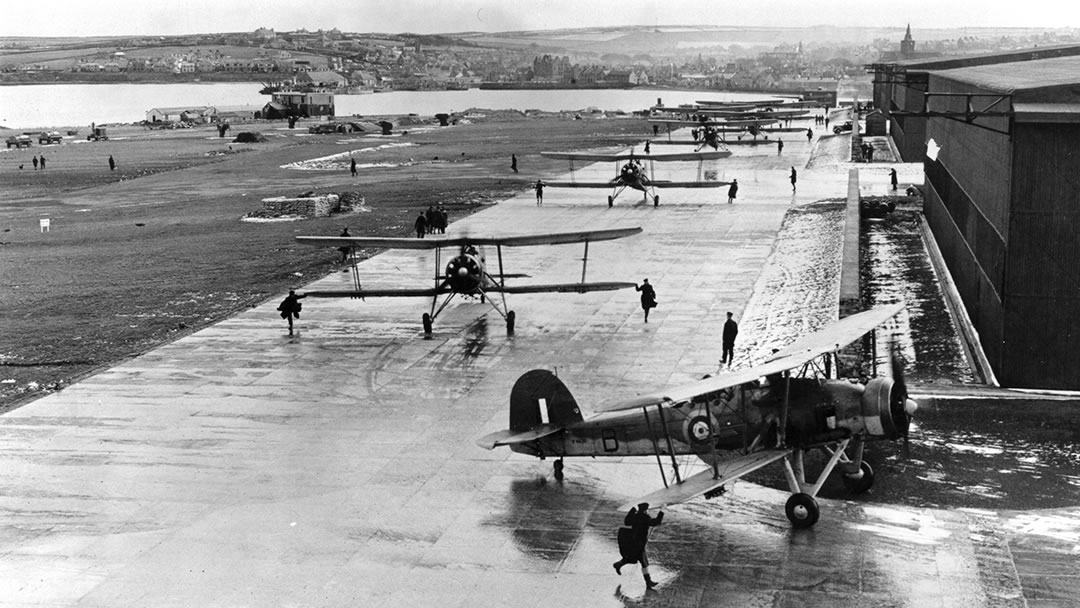
After the war, of the four airfields in Orkney, the one on the former farm of Grimsetter, 2½ miles outside of Kirkwall was chosen as Orkney’s main airport. The hangers at Hatston were used for post war businesses, and Hatston’s life as an industrial estate began.
At Hatston there is an Earth house at Grain from the Iron Age. It was discovered in 1827 and the subterranean building’s purpose is unknown – it was possibly used to store food.
In more recent years, a deep-water harbour was built at Hatston, and this is where cruise ships and cargo vessels arrive in Orkney. It is also where NorthLink’s Aberdeen and Lerwick ferry arrives and departs.
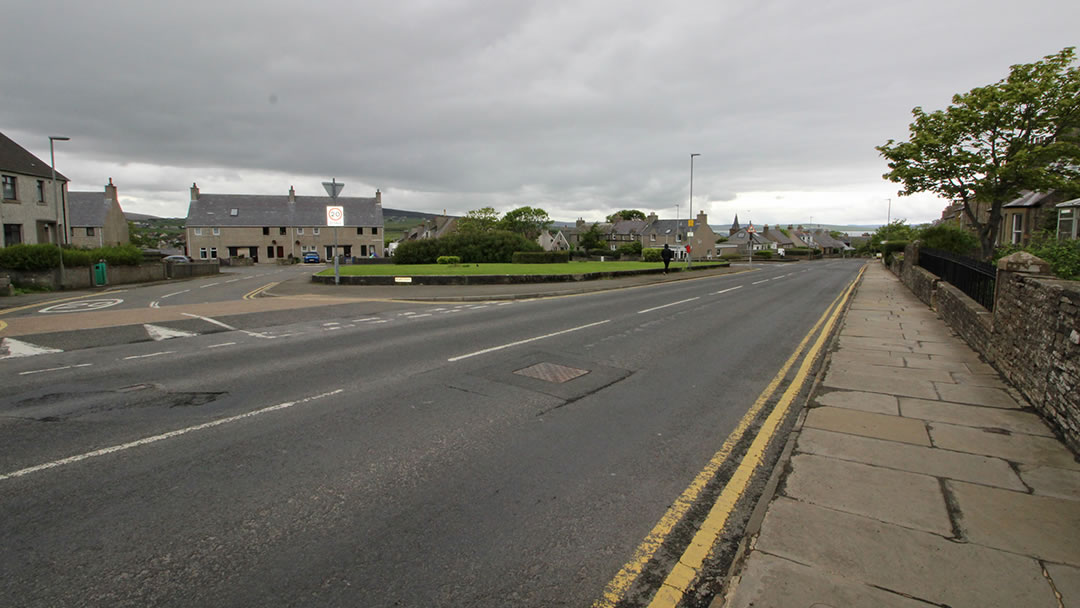
Gallowsha’
One last place in Kirkwall is worth mentioning, but we won’t give it a number. At the very top of the Clay Loan (a steep road which links Junction Road to Bignold Park Road, above the Cathedral) there is a grass-covered square. This is where Kirkwall’s Gallows were.
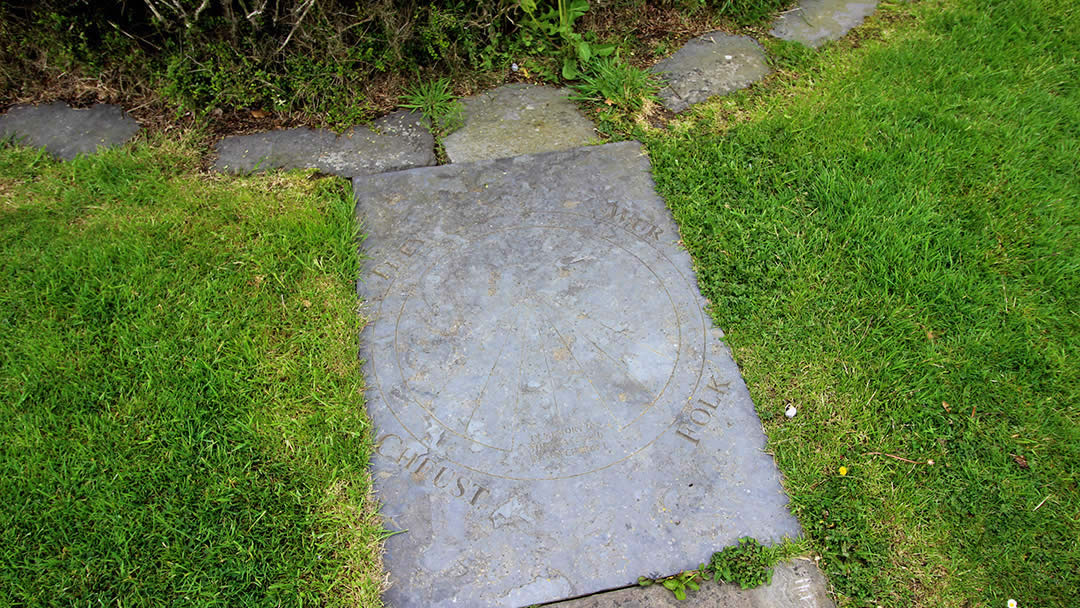
Amongst the many hanged here were innocent women and girls accused of being witches in the 18th Century. In the middle of the grass there is a moving inscription in stone, in memory of those accused of witchcraft, which simply reads ‘they wur cheust folk’.
 By Magnus Dixon
By Magnus DixonOrkney and Shetland enthusiast, family man, loves walks, likes animals, terrible at sports, dire taste in music, adores audiobooks and films, eats a little too much for his own good.
Pin it!